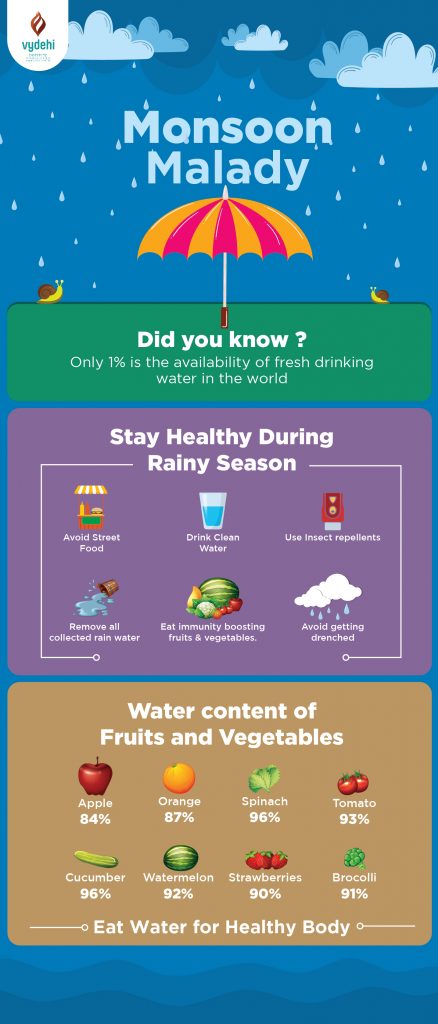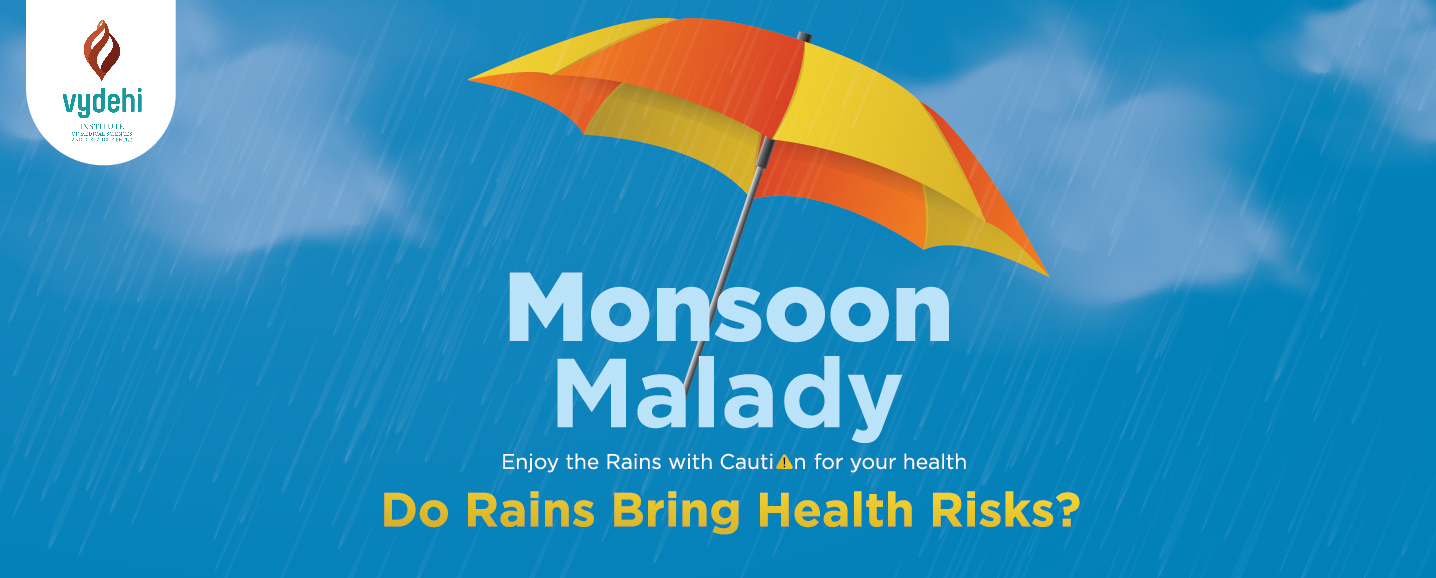Malady, despite sounding poetic, is completely different from Melody. We love the melody like the pitter-patter of the rains, but the maladies or diseases that accompany the monsoon showers, we are better off without.
Although it is great fun to play and dance in the rain, we are often unaware of the fact that the beautiful season also comes with the silent risk of sickness. People with low immunity, small children and the elderly, easily fall prey to the health issues brought on by the rains.
The monsoon season is that time of year when the majority of the region receives its average annual rainfall. India’s geographical location in the tropical region ensures that the country enjoys the rainy season between June and September.
“The drop of rain maketh a hole in the stone, not by violence, but by oft falling.”As rightly said by Lucretius, the ability to be determined enough to achieve something regardless of the setback could very well be a word of caution to stay alert to the hidden dangers of rains. Some of these are Malaria, Dengue, Typhoid, Chikungunya, Cholera, Diarrhoea, Viral Fever, Jaundice, Influenza, Stomach Infection, Leptospirosis, etc
Categorised as Water-borne diseases, Mosquito-borne diseases and Air-borne diseases helps to understand the nature of these infections and take suitable countermeasures.
Water-borne diseases
Water, regardless of being the elixir of life, if stored improperly can be harmful and become contaminated. The surveillance systems in India are not yet adequately in place to capture real-time data. However, as per data from WHO (World Health Organization), more than 3.4 million people are affected by water-borne diseases in India, with the easiest victims being children. These waterborne diseases include
- Typhoid
Salmonella Typhi bacteria cause typhoid, the reasons for which could be contaminated food, water, poor hygiene or sanitation.
- Cholera
Another waterborne disease caused by strains of bacteria is vibrio cholera. Cholera affects the gastrointestinal tract, causing severe dehydration and diarrhoea.
- Jaundice
Symptoms like dark yellow urine, weakness, fatigue, vomiting, and yellowing of the eyes are experienced during jaundice. Poor sanitation is a major cause of this disease.
- Leptospirosis
Things which sound vicious can turn out to actually be vicious, such as Leptospirosis, also known as Weil’s syndrome. Caused by bacterial organisms called Leptospira which thrive in contaminated water, muddy water, and stored water, this is a disease that affects both humans and animals.
Preventive measures
- Use clean water for drinking, and preparing foods, as well as for any physical needs such as bathing and washing.
- Avoid stagnant water storage for longer periods.
- Drinking boiled water and consuming washed fruits and vegetables are also advised to avoid waterborne diseases.
- Check for potholes and drainage in your area. Ensure you wash your hands and feet well with soap if you wade through the puddles.
Mosquito-borne diseases
Ugh!! I hate mosquitoes, don’t you? The cool and wet weather during the monsoons make’s it an ideal breeding time for the fervently hated mosquitoes. This time of the year is known for mosquito-borne diseases such as malaria, dengue, chikungunya, etc.
- Malaria
The most common disease we all are aware of, Malaria is caused by the bite of an infected female Anopheles mosquito, which transmits plasmodium parasites, a life-threatening parasite. Children below the age of 5 years are most easily infected due to this disease.
Though curable and preventable, the disease is often life-threatening and the symptoms can include high fever, body aches, nausea, vomiting, headaches, etc. These symptoms usually appear 10-15 days after a mosquito bite.
- Dengue
Another mosquito-borne disease caused by the bite of a female mosquito is mainly Aedes aegypti.
Stagnant water is the primary cause of dengue, another preventable and curable illness. The symptoms take 4-7 days to get incubated.
- Chikungunya
A non-fatal viral disease caused by the Aedes albopictus mosquito. The difference is that this mosquito breed is active both during the day and night and breeds in stagnant water. Symptoms usually occur within 4–8 days of the bite.
Preventive measures
- Use mosquito nets in the house.
- Use mosquito repellent, liquid or coils.
- Avoid stagnant water in any place for long periods.
- Maintain regular hygiene in the house as well as for yourself.
Airborne diseases
Generally, less threatening and mild, these are diseases which are caused by changes in weather and transmitted by tiny viruses called pathogens. Again, children and senior citizens are more prone to this disease because of their weak or developing immune systems. These diseases include
- Flu and cold
The most viral and common infection is caused by a sudden change in weather and temperature. Weak immune systems are more prone to the disease, and you can feel symptoms such as mild headaches, runny nose, difficulty breathing, sore throat, etc.
- Influenza
Seasonal flu, which is spread due to the transmission of viruses in the air from an infected person, is influenza.

Preventive measures
- Use a handkerchief or hands to cover your mouth while sneezing or coughing.
- Drink boiled or normal water and carry your own water bottle wherever you go.
- Do not forget to gargle if you catch a cold.
- Hands should be washed frequently.
General tips to avoid such diseases:
- Keep yourself hydrated, because the rain outside is not enough for your inner body.
- Eat a balanced diet to keep a strong immune system.
- Use clean and warm water.
- Use of mosquito repellents and personal water bottles is advisable.
- Consume fresh fruits and freshly cooked meals.
- Wear full sleeves and light clothes to protect your skin.
- Try to keep your house as well as your surroundings clean.
Rains bring us untold relief and joy. Yet these can be short-lived pleasures if one turns a blind eye to issues that accompany every cloudburst.
- Non-seasonal rain
With the increase of global warming, the is more water vapour released into the atmosphere resulting in sudden rains even at the peak of summer. These non-seasonal rain can cause health disturbances, some of which could be coughs and colds, fevers, or upset stomachs.
Children are often warned to avoid getting drenched in the non-seasonal rain to prevent the influx of viruses that can trigger infections in the upper respiratory tracts. Those with a history of joint pains or arthritis are likely to experience increased pain and swelling.
- Collected Rain
When technology was not as advanced and developed, people used to store rain on rooftops, large tanks, wells, rain barrels, and other structures and use it for rainwater harvesting and other water uses.
Though it was a great concept in those times, the water collected and stored was often found to be impure and unfit for any kind of consumption. And thus, at times, leading to diseases. Even in today’s world, some areas use this technique to store rain due to the lack of water in their areas. In such extreme situations, it is always advisable to first purify the water before consuming it.
- Acid Rain
Acid rain is brought on by chemical reactions of compounds such as sulphur dioxide and oxides of nitrogen being released into the air and mixing with the wet components present and is mostly a by-product of human activities.
Acid rain not only harms the monuments and sculptures but is more harmful to agriculture, plants, and animals. Acid rain washes away the necessary nutrients for growth and survival and alters the composition of the soil, causing harm to plants and agriculture. It also causes respiratory problems to animals and humans, damages the aquatic ecosystem, and causes pollution.
- Skin issues
Humidity in the air during monsoons, causes itchiness, and increased sweat, and promotes the growth of germs in the body, resulting in itchy bodies and rashes. The most common infections during the monsoon are facial folliculitis (inflammation of the hair follicles), acne, and ringworm.
Some simple preventive measures can safeguard us from the afflictions caused by the monsoon.
- Keeping the body hydrated. Though it rains outside, our bodies need regular hydration.
- Use moisturising creams and lotions to keep the outer layer of the body healthy and itch-free.
- Baths and washes on a regular basis help to keep the body clean fresh and germ-free.
- Choose fabrics that are kind to your skin cotton and other natural fibres help your skin breathe.
The fun and frolic of splashing in rainwater should go hand in hand with these precautionary measures lest the monsoon maladies get the better of you.
Disclaimer: The information included here is only for knowledge-sharing purposes, and the blog is not intended to be a substitute for diagnosis, medical advice, or treatment by a healthcare professional. Every individual needs advice based on diagnosis and evidence, hence the reader should consult their doctor to determine the disease and any treatment must be taken under appropriate medical guidance.
Read About Hydrogen Rich Water – Benefits

 Emergency Number
Emergency Number
Is jaundice a waterborne disease?
Can rain cause a sore throat?